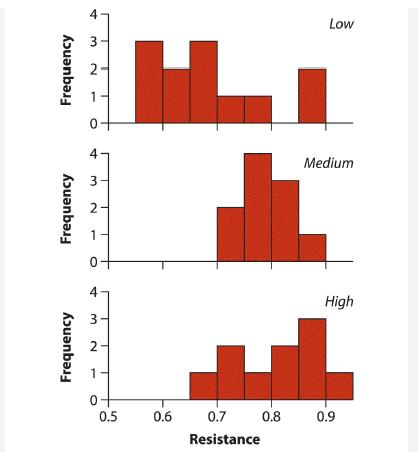Dormant eggs of the zooplankton Daphnia survive in lake sediments for decades, making it possible to measure
Question:
Dormant eggs of the zooplankton Daphnia survive in lake sediments for decades, making it possible to measure their physiological traits in past years. Hairston et al. (1999) extracted Daphnia eggs from sediment cores of Lake Constance in Europe to examine trends in resistance to dietary cyanobacteria, a toxic food type that has increased in density since 1960 in response to increased nutrients in the lake. The data and accompanying histogram give the resistance level of 32 Daphnia clones, each initiated from single eggs extracted from deposits laid down during years of low, medium, and high cyanobacteria density between 1962 and 1997. Resistance is the average growth rate of individuals fed cyanobacteria divided by the growth rate when individuals from the same clone are fed a highquality algal food instead. We wish to test whether resistance differs among Daphnia clones from the three cyanobacteria density groups.

a. Examine the histograms of the data. Give the two main reasons why caution is warranted before using ANOVA to test for differences among group means.
b. The data were analyzed using a Kruskal–Wallis test. What are the null and alternative hypotheses for this test?
c. The results of the test were as follows: H=8.20. What is the conclusion?

d. Under what assumption would we be able to use the results of the test to draw a conclusion about whether the means or medians are the same in the three groups? Is this assumption met here?
Step by Step Answer:

The Analysis Of Biological Data
ISBN: 9781319226237
3rd Edition
Authors: Michael C. Whitlock, Dolph Schluter




